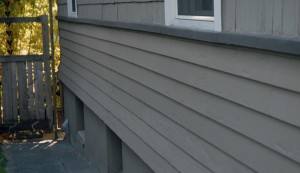I spent much of the holiday weekend scraping, sanding, and painting the clapboards on the south side of the house and had plenty of time to contemplate life’s profundities, questions like “At what point does “shuffle” become indistinguishable from “repeat” on even a long playlist?” and “Who spackles square feet of exterior surfaces?” Most on my mind, though, was this: is there any home improvement task less rewarding than freshening paint? Do the crews painting the Golden Gate feel satisfaction when they finish a coat, or just despair when they have to begin again immediately? Certainly there are worse jobs–anything involving waste lines, for example. But done well, the prep, priming, and painting produce an effect almost indistinguishable from the point where you began. There’s no peeling or fading, but there isn’t the drama of a new color.
The tedium does provide some opportunity for home archaeology. The blue-green I thought was a later color actually looks to be the original, with paint along the clapboards and a matching stain on the shingles. Yellow replaced the blue green at some point, and the current brown went on in 2003–I learned the old paint I was matching was first purchased in that year. The sanding also revealed the milling marks on the clapboard, traces of a circular saw in 100-year-old cedar. These are not earth-shattering revelations, and spot painting is still unrewarding. But at least it doesn’t involve sewer pipes.


